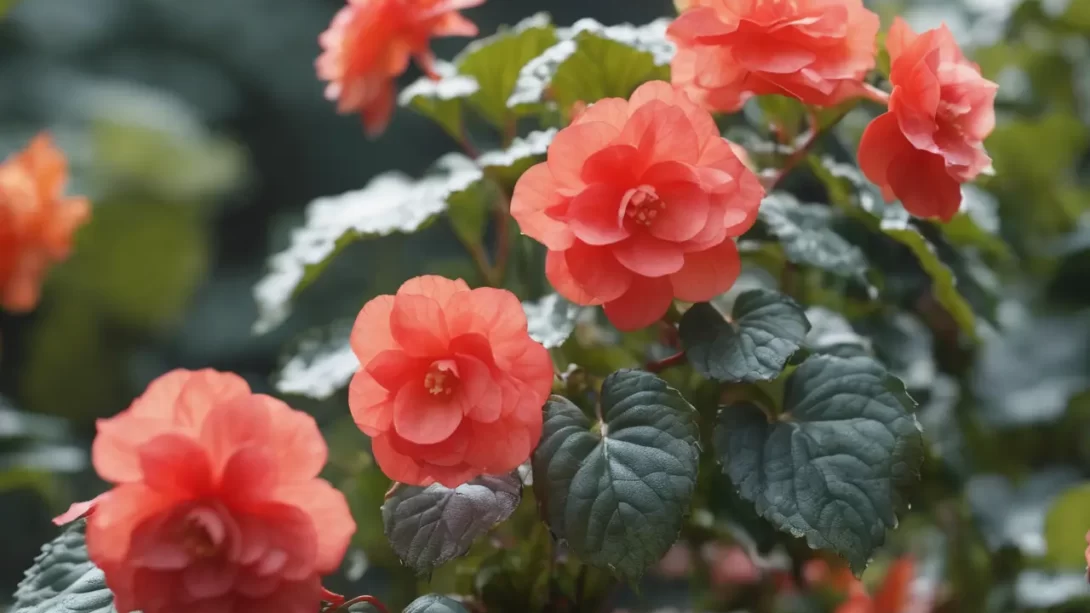Begonias are a diverse and popular group of plants, both as houseplants and garden favorites, known for their beautiful flowers and ornate foliage. A critical aspect of caring for these plants is understanding their specific watering needs. Proper watering is essential to ensure the health and vibrancy of begonias. This article provides a detailed guide on how often to water begonias, taking into account the various factors that influence their hydration requirements.
Begonias
Begonias are classified into three main types: tuberous, fibrous, and rhizomatous, each with unique characteristics and care requirements. Tuberous begonias are celebrated for their large, showy flowers, fibrous begonias are known for their consistent blooming and robust growth, and rhizomatous begonias are prized for their interesting leaves. Despite these differences, a common requirement across all types is the need for a well-balanced watering routine. Begonias generally prefer a moist environment but are susceptible to root rot and other issues if overwatered or left in standing water.
Watering Basics for Begonias
The key to watering begonias effectively is to maintain a balance between moisture and drainage. These plants require soil that is consistently moist but not waterlogged. Overwatering can lead to root rot, while underwatering can stress the plant, leading to wilting and leaf drop. Watering should be done thoroughly, allowing water to seep through the drainage holes at the bottom of the pot, ensuring the entire root system is hydrated. However, it’s crucial to let the top layer of soil dry out slightly between waterings. This method helps to prevent the issues associated with both over and underwatering.
Factors Influencing Watering Frequency
Several key factors determine how often you should water your begonias, making it essential to understand and observe your plants closely:
- Pot Size and Type: The size and material of the pot impact how quickly the soil dries out. Smaller pots dry out faster than larger ones, and porous materials like terracotta allow for more evaporation compared to plastic.
- Soil Mix: Begonias thrive in well-draining soil that retains some moisture. Soil that is too dense or retains too much water can lead to root problems, while a very light, airy mix might dry out too quickly.
- Environmental Conditions: The amount of light, temperature, and humidity in your begonia’s environment will affect its watering needs. Higher light and temperatures can cause the soil to dry out more rapidly, necessitating more frequent watering. Conversely, in lower light or cooler temperatures, water less often.
- Variety of Begonia: Different types of begonias may have slightly different watering needs. For instance, rhizomatous begonias may prefer drier conditions compared to the more moisture-loving tuberous varieties.
Typical Watering Schedule for Begonias
While specific watering needs can vary, some general guidelines can be helpful:
- During Active Growth: In warmer months or during their growing season, begonias typically require more frequent watering. This could mean watering once every few days, depending on the factors mentioned above.
- During Dormant Periods: In cooler months or when growth slows down, reduce the frequency of watering. This might mean watering once a week or less, but always check the soil moisture before adding more water.
It’s important to adjust your watering routine according to these cycles and to the specific needs of your plant, as overwatering can be just as harmful as underwatering.
Signs of Improper Watering
Recognizing the signs of improper watering can help you adjust your care routine to better suit your begonias’ needs. Overwatering often leads to root rot, a condition indicated by yellowing leaves, a mushy stem base, or a moldy soil surface. On the other hand, underwatering can cause the leaves to wilt, turn brown at the edges, and the soil to feel dry to the touch.
Best Practices for Watering Begonias
To ensure your begonias receive the right amount of water, consider the following best practices:
- Use the Right Water: Begonias can be sensitive to chemicals in tap water. If possible, use lukewarm, distilled, or rainwater for watering.
- Check Soil Moisture: Before watering, verify the soil moisture by feeling the top inch of the soil. Only water if it feels dry. For a more accurate assessment, consider using a moisture meter.
- Avoid Water on Leaves: When watering begonias, try to keep the water off the leaves to prevent leaf spot diseases. Water directly at the base of the plant.
- Empty Excess Water: If you’re using a saucer beneath the pot, make sure to empty it after watering to avoid letting the roots sit in stagnant water.
Additional Care Tips
Complementing your watering routine with overall good care practices will help keep your begonias healthy:
- Fertilization: Feed your begonias with a balanced fertilizer during their growing season to encourage robust growth and flowering.
- Humidity Control: Begonias enjoy a humid environment. Consider using a humidifier or placing a water tray near the plant to maintain adequate humidity, especially in dry conditions.
- Proper Lighting: Ensure your begonias receive the right amount of light, which is typically bright, indirect light for most varieties.
- Regular Pruning: Remove dead or dying leaves and flowers to encourage new growth and prevent disease.
Conclusion
Watering begonias correctly is crucial for their health and beauty. By understanding the factors that influence their watering needs, monitoring for signs of over or underwatering, and following best practices for plant care, you can maintain thriving and vibrant begonias. Each begonia may have unique requirements, so observe your plants closely and adjust your care routine as needed. With proper attention and care, your begonias will be a stunning addition to your indoor garden or outdoor landscape.




